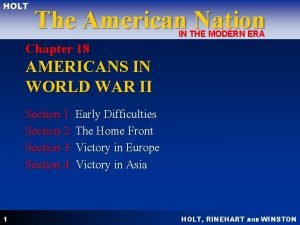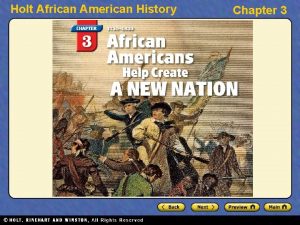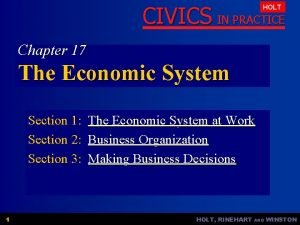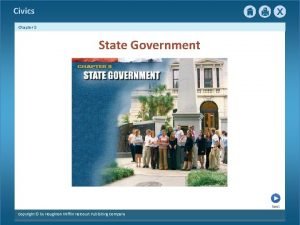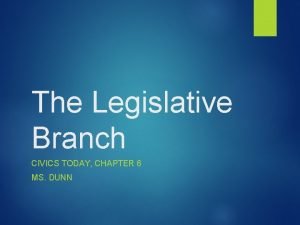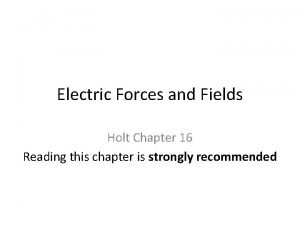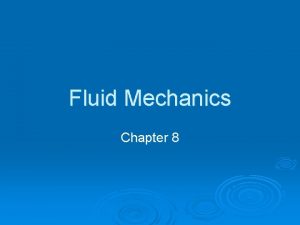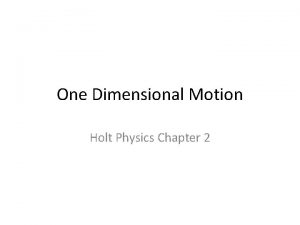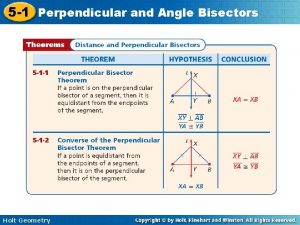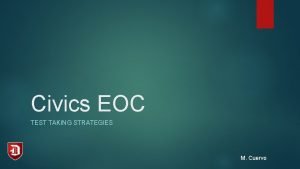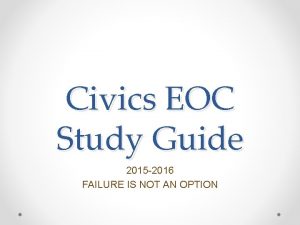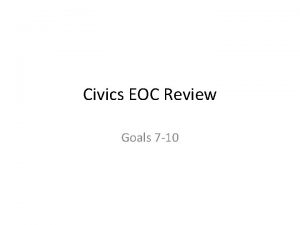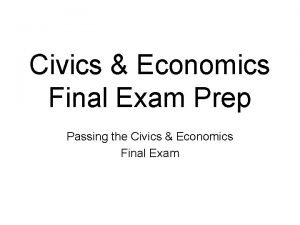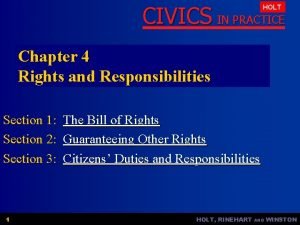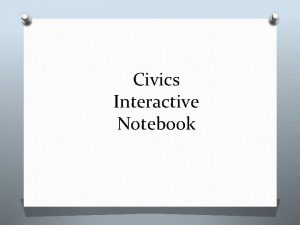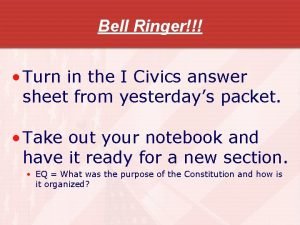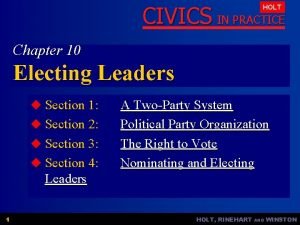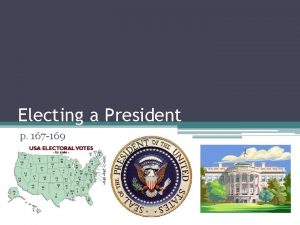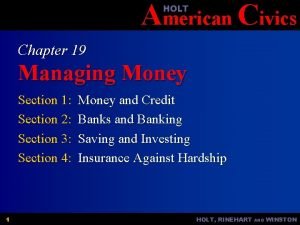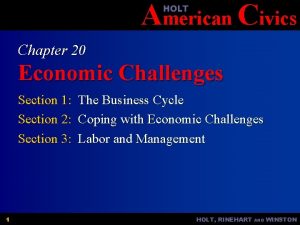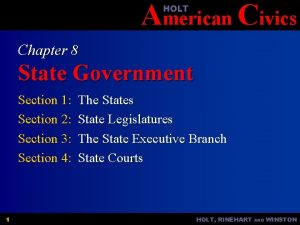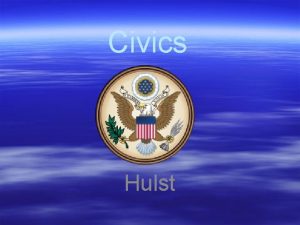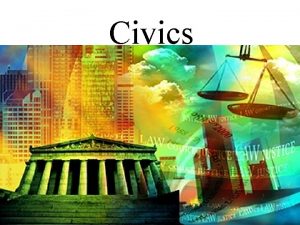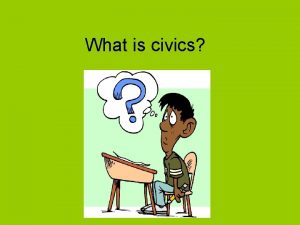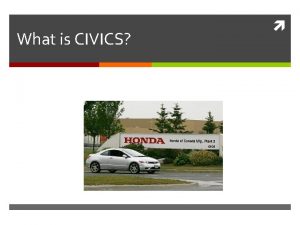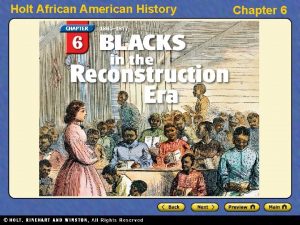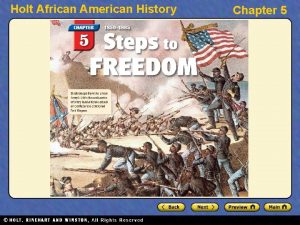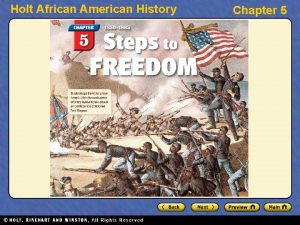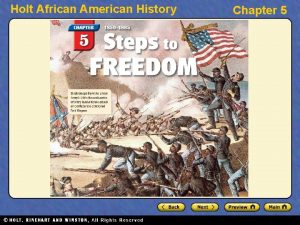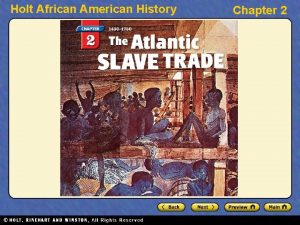American Civics HOLT Chapter 10 Electing Leaders Section



















- Slides: 19

American Civics HOLT Chapter 10 Electing Leaders Section 1: Section 2: Section 3: Section 4: 1 A Two-Party System Political Party Organization The Right to Vote Nominating and Electing Our Leaders HOLT, RINEHART AND WINSTON

American Civics HOLT Chapter 10 Section 1: A Two-Party System OBJECTIVES u What is the role of political parties in the United States? u How did political parties develop in the United States? u How do one-party and two-party political systems differ? 2 HOLT, RINEHART AND WINSTON

American Civics HOLT Chapter 10 Section 1: A Two-Party System Political parties in the United States: u Way for large groups with similar ideas to get things done u Take positions on public issues and work to pass laws u Allows individuals to have a stronger voice within a group u Parties must compromise and work together 3 HOLT, RINEHART AND WINSTON

American Civics HOLT Chapter 10 Section 1: A Two-Party System The development of political parties in the United States: u Federalists—believed in strengthening the central government u Antifederalists (Democratic-Republicans) tried to limit the power of the federal government. u 1820 s—Andrew Jackson led the Democratic Party; determined the government should represent the “common people” u 1854—Republican Party formed by antislavery groups; nominated Abraham Lincoln for president in 1860 4 HOLT, RINEHART AND WINSTON

American Civics HOLT Chapter 10 Section 1: A Two-Party System One-party and two-party political systems: u One-party systems—dictatorships or totalitarian governments; one group or person has power; people do not have essential freedoms u Two-party systems—create stable governments; allow for majority rule; voters have a choice 5 HOLT, RINEHART AND WINSTON

American Civics HOLT Chapter 10 Section 2: Political Party Organization OBJECTIVES u What are the committees that help major political parties, and what are their responsibilities? u Where do political parties get their money, and why does Congress regulate political contributions? u How does the Federal Election Campaign Act regulate federal campaigns? 6 HOLT, RINEHART AND WINSTON

American Civics HOLT Chapter 10 Section 2: Political Party Organization Party committees and their responsibilities: u National committee—sets dates, rules, and location of national convention; publishes and distributes literature; arranges speakers; aids presidential candidate u State central committees—supervise operations within the states; maintain harmony and organization; raise money and aid candidates u Local committees—conduct campaigns; recommend appointments and candidates; raise money; crucial to party success; precinct captains encourage voters to cast ballots for the party’s candidates 7 HOLT, RINEHART AND WINSTON

American Civics HOLT Chapter 10 Section 2: Political Party Organization Money and Regulations u Private contributions make up a large percentage of funds. u Business groups, labor unions and other groups also contribute. u Large fund-raising events are held by each party. u Fear of corruption prompted Congress to regulate the size of donations. 8 HOLT, RINEHART AND WINSTON

American Civics HOLT Chapter 10 Section 2: Political Party Organization Federal Election Campaign Act u 1972—Federal Election Campaign Act passed to lessen the possibility of corruption u FECA limits size of contributions and requires a report of donors. u Soft money remains difficult to monitor. u The Presidential Election Campaign Fund gives public funds to qualified candidates who can then no longer receive private donations. 9 HOLT, RINEHART AND WINSTON

American Civics HOLT Chapter 10 Section 3: The Right to Vote OBJECTIVES u Who can vote in U. S. elections, and how is this right protected? u What is the difference in primary elections and general elections? u How has the voting process changed over the years? 10 HOLT, RINEHART AND WINSTON

American Civics HOLT Chapter 10 Section 3: The Right to Vote Voting Rights in U. S. Elections u All U. S. citizens over the age of 18 are eligible to vote. u States cannot deny the right to vote based on race, color, or sex. u The Voting Rights Act protects voters’ rights. u Disqualified voters include prison inmates, mentally incompetent persons, election-law violators, and persons with no established residence. u Voters must register prior to an election. 11 HOLT, RINEHART AND WINSTON

American Civics HOLT Chapter 10 Section 3: The Right to Vote Primary Elections u Allows registered voters to choose the party candidates u Closed primary: only party members can vote for each party’s candidate u Open primary: voters can vote for either party’s candidates 12 HOLT, RINEHART AND WINSTON

American Civics HOLT Chapter 10 Section 3: The Right to Vote General Elections u Registered voters choose the leaders. u Organizations, newspapers, radio, television, and magazines help inform voters. 13 HOLT, RINEHART AND WINSTON

American Civics HOLT Chapter 10 Section 3: The Right to Vote Changes in the voting process: u Early 1800 s—voting was by voice u 1888—secret ballots adopted to ensure fairness and honesty u 1960 s—Mechanical lever machines were most common u Punchcards, mark-sense, and direct recording electronic systems are other paper-ballot alternatives. 14 HOLT, RINEHART AND WINSTON

American Civics HOLT Chapter 10 Section 4: Nominating and Electing Our Leaders OBJECTIVES u What is the purpose of national nominating conventions, and how are convention delegates chosen? u What is the nomination process at the national conventions? u What are some methods of presidential campaigning? u What is the main purpose of the electoral college? 15 HOLT, RINEHART AND WINSTON

American Civics HOLT Chapter 10 Section 4: Nominating and Electing Our Leaders National nominating conventions and choosing delegates: u Delegates are elected in primaries or selected by party u u u 16 leaders. Additional delegates are determined by different formulas. Parties agree on a platform and select a candidate at national conventions. Conventions are huge, televised events intended to spread the party’s message to voters. HOLT, RINEHART AND WINSTON

American Civics HOLT Chapter 10 Section 4: Nominating and Electing Our Leaders The nomination process at the national conventions: u State-by-state roll call and nominating speeches for candidates u Favorite sons or daughters nominated to honor or delay decision u Balloting of the delegates ensues until candidate is chosen u Delegates nominate the vice president based on ability win votes u Presidential candidates have the strongest voice regarding the choice for vice president. 17 HOLT, RINEHART AND WINSTON

American Civics HOLT Chapter 10 Section 4: Nominating and Electing Our Leaders Methods of presidential campaigning: u Television and other media advertise candidates’ views. u Presidential debates (televised since 1960 s) u Computers offer online campaigning. u Personal-appearance tours u Telephone campaigning urges citizens to vote. 18 HOLT, RINEHART AND WINSTON

American Civics HOLT Chapter 10 Section 4: Nominating and Electing Our Leaders The main purpose of the electoral college: u Electors cast the official votes for presidency based on the popular vote in each state. u The framers of the Constitution worried citizens would not be able to choose wise leaders. u The relevancy of the electoral college today is in debate. 19 HOLT, RINEHART AND WINSTON
 Holt american nation
Holt american nation Holt african american history
Holt african american history Civics in practice
Civics in practice Chapter 8 civics
Chapter 8 civics Bicameral legislature
Bicameral legislature Holt physics chapter 16 test
Holt physics chapter 16 test Holt physics chapter 8 fluid mechanics test answers
Holt physics chapter 8 fluid mechanics test answers A man named bungkas climbed a palm tree
A man named bungkas climbed a palm tree 5-3 perpendicular and angle bisectors
5-3 perpendicular and angle bisectors Sejarah perkembangan civics dan pendidikan kewarganegaraan
Sejarah perkembangan civics dan pendidikan kewarganegaraan Civics 360 .org
Civics 360 .org Civics sol review
Civics sol review Civics 360.org
Civics 360.org Civics eoc study guide
Civics eoc study guide Civics eoc review
Civics eoc review Civics eoc practice
Civics eoc practice Civics and economics final exam
Civics and economics final exam Civics in practice
Civics in practice Interactive notebook table of contents
Interactive notebook table of contents Lejsasr
Lejsasr
